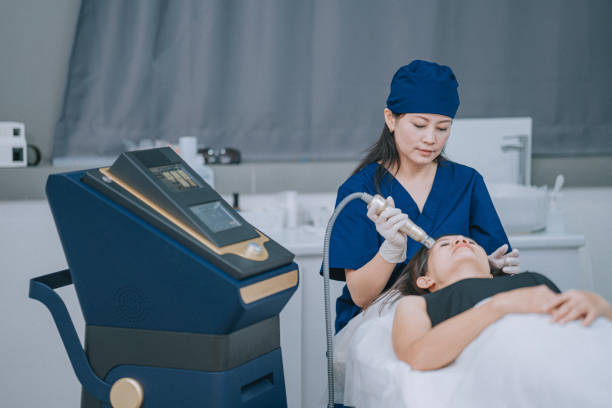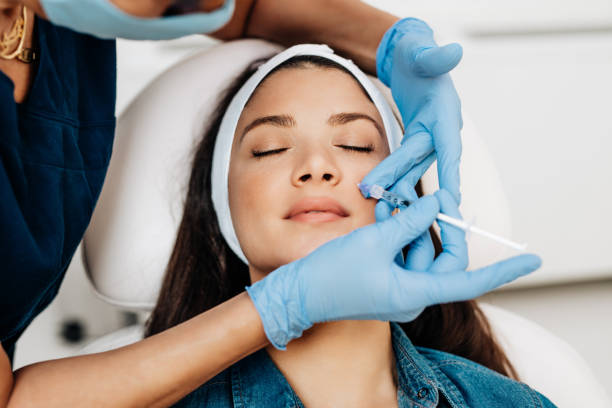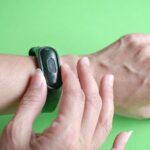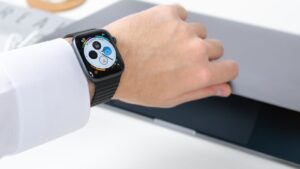
Asian Chinese female Aesthetician giving Microdermabrasion IPL treatment to her patient
Microdermabrasion and dermaplaning are both popular skin care procedures that can help improve skin texture, reduce wrinkles, and even out skin tone. But, what’s the difference between the two? Knowing the basics of each procedure is the first step in determining which one is right for you. Let’s dive into the details of microdermabrasion vs dermaplaning to help you make your decision.
What Is Microdermabrasion?
Microdermabrasion is a non-invasive skin resurfacing technique that uses fine crystals or a diamond tip wand to exfoliate the top layer of your skin, revealing a smoother and brighter complexion.
Microdermabrasion and dermaplaning are two popular exfoliating procedures that can improve the overall appearance of your skin, but they work differently. Dermaplaning uses a surgical-grade blade to remove fine hairs and dead skin cells from the surface of your skin, leaving it smooth and free of impurities. Unlike microdermabrasion, dermaplaning doesn’t involve any suction or abrasive particles and is ideal for people with sensitive skin.
Whether you should go for microdermabrasion or dermaplaning depends on your specific skin goals and concerns. Microdermabrasion works well for a wide range of skincare issues, including fine lines, wrinkles, dark spots, and enlarged pores. Dermaplaning is a better choice for people looking to address peach fuzz, minor acne scarring, or hyperpigmentation. A trained esthetician can help you decide which exfoliation technique is right for you based on your skin type, needs, and preferences.
What Is Dermaplaning?
Dermaplaning is a non-invasive cosmetic procedure that involves using a sharp, surgical blade to gently scrape the surface of the skin. Dermaplaning removes dead skin cells, vellus hair (peach fuzz), and debris from the skin’s surface, revealing a smoother, brighter complexion.
Microdermabrasion and dermaplaning are both exfoliating treatments that help improve the appearance of the skin but work differently. While microdermabrasion uses a device that sprays hard particles onto the skin to remove dead skin cells, dermaplaning uses a surgical blade to scrape the top layer of the skin.
Deciding between microdermabrasion or dermaplaning depends on your skin type and desired results. Dermaplaning is ideal for those with dry or sensitive skin, while microdermabrasion is suitable for oily or acne-prone skin types. Consult with a dermatologist or skincare expert to determine which procedure is best for you.
Microdermabrasion vs Dermaplaning
Microdermabrasion and dermaplaning are two popular exfoliating treatments that deliver instant skin rejuvenation. The main differences between the two treatments are the tools and techniques used, as well as the skin issues they address. Microdermabrasion uses tiny crystals to exfoliate the outer layer of the skin and remove dead skin cells. This treatment is ideal for people with dull or rough skin, fine lines and wrinkles, acne scars, or hyperpigmentation.
Dermaplaning, on the other hand, uses a surgical blade to shave off the top layer of dead skin cells and fine hairs from the face. This treatment is recommended for people with fine lines and wrinkles, uneven skin tone, acne scars or hyperpigmentation, and peach fuzz. While both treatments deliver similar results and are safe for most skin types, choosing the right treatment ultimately depends on your skin goals and skin concerns. Consulting with a skincare professional can help you determine which treatment is best for you.
Pro Tip: To avoid the risk of infection, it’s recommended that only licensed and experienced skincare professionals perform both microdermabrasion and dermaplaning treatments.
Pros and Cons of Microdermabrasion and Dermaplaning
When it comes to skin treatments, Microdermabrasion and Dermaplaning have become popular methods to improve skin texture and clarity. Each type of treatment has its own benefits and drawbacks. Let’s look at the pros and cons of both treatments to help you decide which one might be right for you.
Pros of Microdermabrasion
Microdermabrasion is a non-invasive cosmetic procedure that exfoliates and rejuvenates the skin offering multiple benefits.
Some of the Pros of Microdermabrasion are:
- Reduces Fine Lines and Wrinkles: Microdermabrasion helps reduce the appearance of fine lines and wrinkles by stimulating collagen production.
- Treats Hyperpigmentation: Microdermabrasion helps fade dark spots and hyperpigmentation caused by sun damage, aging, or acne.
- Improves Skin Texture: This procedure smoothens the skin’s texture by removing dead skin cells, unclogging pores, and reducing the size and appearance of pores.
- Quick Procedure and Little Downtime: Microdermabrasion is a quick and painless procedure that requires no downtime, allowing patients to return to their daily activities immediately.
When choosing between microdermabrasion vs dermaplaning, it is essential to consider your skin type, the specific skin concerns, and your budget to determine which treatment is suitable for you.

Cons of Microdermabrasion
Microdermabrasion is an effective skin treatment procedure that uses microcrystals or exfoliating tools to remove dead skin cells and smooth out fine lines and wrinkles. However, it also has some drawbacks that need to be considered before deciding on this procedure.
Some of the cons of Microdermabrasion are:
- It may cause redness, swelling, and bruising of the skin, especially if you have sensitive skin or if the treatment is performed improperly.
- It may trigger acne breakouts or skin infections if the exfoliating tools are not cleaned properly or if the skin is not well-prepped before the procedure.
- It may not work well for deep wrinkles, scars, or pigmentation issues, as it only targets the surface layer of the skin.
On the other hand, dermaplaning is a gentler and more precise exfoliation technique that uses a scalpel to remove dead skin cells and vellus hairs from the face, leaving the skin smoother and brighter. It has some unique pros and cons compared to microdermabrasion, making it a viable alternative or complementary treatment option.
Pro Tip: Consult with a dermatologist or esthetician to determine which exfoliation technique is best suited to your skin type and condition.
Pros of Dermaplaning
Dermaplaning is a cosmetic treatment that involves using a sharp surgical blade to gently exfoliate the skin, removing dead skin cells, and the fine hair on the face. It has several pros that make it a popular choice among people looking for a non-invasive way to rejuvenate their skin.
Some of the pros of dermaplaning include:
- Improved Skin Texture: Dermaplaning removes dead skin cells and fine hair from the face, making it smoother and softer.
- Enhances Product Absorption: With the top layer of dead skin cells removed, skincare products can easily penetrate the skin, making them more effective.
- No Downtime: Unlike other facial treatments, dermaplaning does not require any downtime. It’s a quick and painless procedure that takes less than 30 minutes.
However, it’s important to note that dermaplaning is not suitable for all skin types and has a few potential cons. It’s always recommended to consult a dermatologist to determine if it’s the right treatment for you.
Cons of Dermaplaning
While Dermaplaning is an effective method for exfoliating the skin, it does come with a few cons that may not make it suitable for everyone.
Here are some of the cons to keep in mind:
- Increased sensitivity: Dermaplaning removes the top layer of the skin, which can increase sensitivity to the sun and certain skincare products.
- Bruising: The technique used in dermaplaning can cause small bruises, especially around the eyes.
- Temporary results: Dermaplaning provides temporary results that last for about three weeks to a month. After that, you need to repeat the process to maintain the results.
When comparing microdermabrasion vs. dermaplaning, it’s important to consider these cons along with the pros to determine which option is right for you. Microdermabrasion is a gentler alternative that does not involve the use of a sharp blade, making it less likely to cause sensitivity and bruising. So, if you have sensitive skin or are prone to bruising, microdermabrasion may be a better option for you.
Pro tip: Consult with a skincare professional to determine which method is best for your skin type and conditions.
Choosing Between Microdermabrasion and Dermaplaning
Microdermabrasion and Dermaplaning are two popular skin treatments that offer a vast range of cosmetic benefits. Each procedure offers its own unique set of benefits and drawbacks, so it’s important to know what each one entails before deciding which is right for you. In this article, we will discuss the differences between microdermabrasion and dermaplaning and how they can help you achieve the results you’re looking for.
Factors To Consider When Choosing Between the Two
When deciding between microdermabrasion and dermaplaning, there are several factors to consider to determine which treatment is best for your skin and beauty goals.
Microdermabrasion is a skin resurfacing procedure that involves using a specialized tool to remove dead skin cells and improve the overall texture and tone of the skin. This treatment is ideal for individuals with fine lines, wrinkles, hyperpigmentation, and clogged pores. Dermaplaning, on the other hand, involves using a small, sterile blade to carefully remove the top layer of dead skin cells and fine hair from the face. This treatment is ideal for individuals with dry skin, dull skin, and peach fuzz.
To determine which treatment is right for you, consider factors such as your skin type, skin concerns, budget, and recommended downtime. For example, microdermabrasion may be a better choice for those with oily or acne-prone skin, while dermaplaning may be a better choice for those with sensitive or dry skin. Consult with a licensed aesthetician or dermatologist to determine which treatment is best for you and your skincare needs.
Skin Type Considerations For Microdermabrasion and Dermaplaning
Before deciding between Microdermabrasion and Dermaplaning, it is important to consider your skin type and its unique needs. Each treatment caters to different skin types and may produce different results.
Microdermabrasion: This treatment uses a diamond or crystal-tipped wand to exfoliate the skin’s surface, making it ideal for combating fine lines, wrinkles, sun damage, and acne scarring. It works well on most skin types, except for those with rosacea, eczema, or sensitive skin. Dermaplaning: This treatment uses a surgical-grade scalpel to remove the top layer of dead skin cells and vellus hair (peach fuzz) from the face. It leaves skin looking smooth and vibrant, making it ideal for those with dull, dry, or aging skin. It is not recommended for those with acne-prone or sensitive skin.
Consider your skin type and its specific needs before choosing between Microdermabrasion and Dermaplaning. Consult a licensed esthetician or dermatologist to determine which treatment will work best for you.
Which One Is Right For You? A Guide To Making the Decision
Choosing between microdermabrasion and dermaplaning can be a daunting decision, but ultimately it depends on your skin type, the issues you’re looking to address, and your unique preferences.
Dermaplaning involves using a blade to gently scrape off dead skin cells and fine hairs, resulting in a smoother, brighter complexion. This technique is best suited for those with dry or sensitive skin and can be done every 4-6 weeks. Microdermabrasion, on the other hand, involves using a minimally abrasive instrument to buff away the outermost layer of skin, stimulating collagen production and improving the appearance of fine lines, age spots, and acne scarring. This technique is ideal for those with oily or acne-prone skin and can be done every 2-4 weeks.
Pro Tip: Consult with a licensed dermatologist or esthetician to determine which technique is best suited to your skin type and needs.

The Microdermabrasion and Dermaplaning Process
Microdermabrasion and dermaplaning are both skin resurfacing treatments that can help improve the appearance of skin. Their process is different, and so is the way these two treatments can benefit your skin. In this article, we’ll take a closer look at the microdermabrasion and dermaplaning process to help you determine which one is right for you.
What To Expect During a Microdermabrasion Treatment
Microdermabrasion is a popular and safe exfoliating treatment that uses a fine abrasive instrument to gently remove the outer layer of dead skin cells.
Here’s what to expect during a typical microdermabrasion treatment:
- Your esthetician will cleanse your face thoroughly to remove dirt and makeup.
- A handheld wand will be used to deliver tiny exfoliating crystals to your skin. Alternatively, a diamond-tip wand may be used for a gentler treatment. This process will cause a suction to occur at the wand tip to remove the dead skin cells.
- The wand will be moved over your entire face in a circular pattern.
- A calming or refreshing serum will be applied as a final step.
Compared to dermaplaning, which is an exfoliating treatment that removes dead skin cells and facial hair, microdermabrasion is noninvasive and works on the outermost layer of the skin. Dermaplaning is deeper and removes fine vellus hair from the face. Whether microdermabrasion or dermaplaning is right for you mostly depends on your skin type and the results you want to achieve. It is best to have a conversation with your esthetician and let them inform you on the best option for your skin type.
Pro Tip: Ensure that your skin is clean and free of any active breakouts, sunburn, or excessive oil before booking a microdermabrasion treatment.
What To Expect During a Dermaplaning Treatment
Dermaplaning is a cosmetic procedure that involves the use of a medical-grade scalpel to remove dead skin cells and fine hairs from the surface of your skin. It is often compared to microdermabrasion and is a great option if you are looking for a non-invasive way to exfoliate and rejuvenate your skin.
Here’s what to expect during a dermaplaning treatment:
- The esthetician will start by cleansing your skin and applying a thin layer of oil to help the scalpel glide over your skin smoothly.
- Using the scalpel at a 45-degree angle, the esthetician will gently scrape the surface of your skin to remove the dead skin cells and fine hairs.
- Once the treatment is complete, the esthetician will apply a soothing serum or mask to your skin.
- You may experience some redness and sensitivity immediately after the procedure, but this should subside within a few hours.
Unlike microdermabrasion, dermaplaning is not recommended for people with active acne or inflammatory skin conditions.
Pro tip: Be sure to wear sunscreen after your dermaplaning treatment, as your skin will be more sensitive to the sun’s UV rays.
Recovery Time For Both Procedures
Both microdermabrasion and dermaplaning are non-invasive cosmetic procedures that offer several benefits for the skin. However, the recovery time for each procedure can vary based on several factors.
Microdermabrasion: This procedure involves exfoliating the outermost layer of the skin using tiny crystals. Microdermabrasion has little to no downtime, and most people can resume their daily activities immediately after treatment. However, some individuals may experience mild redness, sensitivity, or flaking, which can last for up to a week.
Dermaplaning: This procedure involves using a surgical scalpel to gently remove the top layer of dead skin and fine hair. Dermaplaning has a similar recovery period to microdermabrasion, with most individuals experiencing little to no downtime. Mild redness, sensitivity, or dryness may occur, but these symptoms typically resolve within a few days.
If you’re unsure which procedure is right for you, consider consulting with a skincare professional who can recommend the best option for your skin type and concerns.
Conclusion: Final Thoughts On Microdermabrasion and Dermaplaning
When it comes to choosing between microdermabrasion and dermaplaning, several factors must be considered.
Microdermabrasion is best suited for people looking to address concerns such as fine lines, wrinkles, acne scars, and hyperpigmentation. The treatment uses tiny crystals or exfoliating discs to remove dead skin cells gently. It is a painless and quick treatment that can be done at a spa or esthetician’s office. Dermaplaning, on the other hand, is perfect for people prone to acne, oily skin, or unwanted peach fuzz. It involves a sterile surgical blade to remove dead skin cells gently and vellus hair, resulting in smooth and glowing skin.
Ultimately, whether microdermabrasion or dermaplaning is right for you depends on your specific skincare concerns and goals. Consulting with a dermatologist or licensed esthetician can help determine which treatment may be most effective for you. So, whether it’s microdermabrasion or dermaplaning that you choose, both treatments can rejuvenate and refresh your skin, giving you a radiant and youthful appearance










